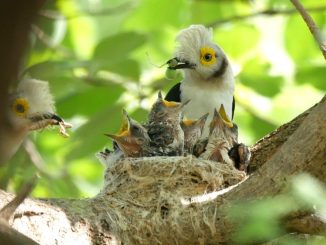Introduction
In the arid and unforgiving landscapes of deserts, one bird stands out as a true marvel of adaptation – the Pintail Sandgrouse. These desert-dwelling avians, scientifically known as Pterocles alchata, have developed extraordinary strategies for surviving in some of the harshest environments on Earth. This blog post will explore the remarkable characteristics, behaviors, and adaptations that make the Pintail Sandgrouse a true desert survivor.
Body
1. A Desert Icon

Pintail Sandgrouse are iconic birds of arid regions across North Africa, the Middle East, and southern Europe. They are well-adapted to life in deserts, where water is scarce and survival is a daily challenge. Their medium-sized bodies are covered in cryptic plumage, allowing them to blend into the sandy landscape and escape the notice of predators.
2. The Water-Carrying Miracle

One of the most fascinating aspects of Pintail Sandgrouse behavior is their unique ability to carry water to their nests. These birds have specialized feathers on their underbellies that soak up water like a sponge. They fly to distant water sources, such as oases or puddles, and dip their belly feathers to collect water. Once saturated, they return to their nests and let their chicks drink from this mobile water supply – an astonishing feat of avian ingenuity.
3. Nurturing Parents

Pintail Sandgrouse exhibit strong parental care. Both male and female birds take turns in caring for the eggs and young. This cooperative breeding strategy allows them to share the responsibilities of incubation and feeding, ensuring the survival of their chicks in harsh desert conditions.
4. Habitat and Adaptations

The Pintail Sandgrouse’s habitat primarily consists of arid and desert regions. They are known for their long wings, which aid in their efficient, long-distance flights between foraging sites and water sources. Their diet mainly consists of seeds and grains found in the desert, which they use their specialized beaks to crack open.
5. Conservation and the Fragile Desert Ecosystem

Desert ecosystems are delicate and vulnerable, making it crucial to understand and protect species like the Pintail Sandgrouse. Habitat destruction, climate change, and water scarcity in arid regions are significant threats to their survival. Conservation efforts must focus on preserving these unique birds and the habitats they rely on to ensure their continued existence in the world’s deserts.
Conclusion
In conclusion, the Pintail Sandgrouse exemplifies the incredible adaptations that birds can develop to thrive in the harshest environments on Earth. Their water-carrying behavior and cooperative parenting highlight the remarkable strategies they employ to survive in arid landscapes. By studying and conserving these desert marvels, we can better understand the fragile balance of desert ecosystems and the importance of protecting these unique species.
Fecal content.
The Pintail Sandgrouse’s ability to carry water to its nest is a testament to the extraordinary adaptations that birds can develop in challenging environments. I hope this blog post sheds light on the fascinating world of these desert survivors and the importance of preserving their fragile ecosystems. If you have any specific details or points you’d like to include or need further assistance, please let me know!


